Gerald Almy | Originally published in GameKeepers: Farming for Wildlife Magazine. To subscribe, click here.
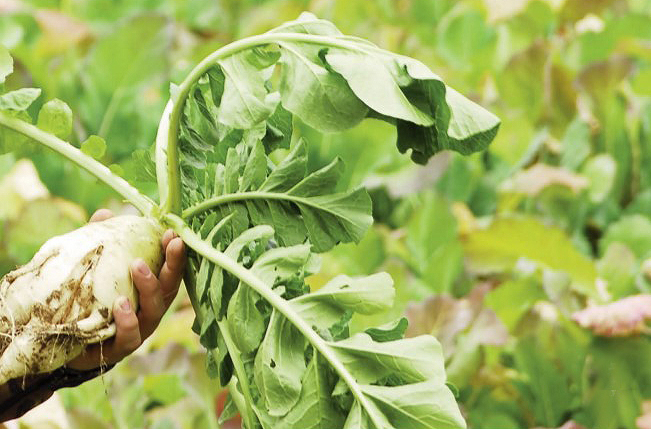
I knew the rack would not score well, but I also knew it was an old whitetail deer. With five average points on one side, three short, clubby ones on the other, it was a buck I had watched for three years make no improvements other than a slight increase in mass. At first, I’d hoped it was an injury and he’d snap back the next season, but time had proven otherwise.
Every year, he looked basically the same. I had seen him chase does, so I knew he was breeding and passing on his less-than-stellar genes to the local herd. It was time to use one of my two Virginia buck tags. When he lowered his head to take another bite from the lush, green food plot, I squeezed the crossbow trigger and watched as the bolt found its mark. Even with the smallish rack, his tooth wear and body size confirmed he was definitely a mature deer, most likely five years old — an animal I was grateful to harvest because of his age alone.
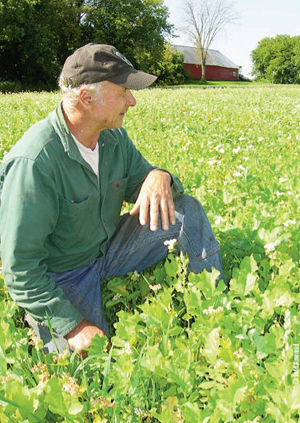
The food that drew this buck out of the nearby woods was one that is drawing more and more interest from sportsmen and gamekeepers every year: Deer Radish. Radish! Ten years ago, I would never have believed I’d be using that word as a deer food plot staple instead of a salad ingredient. Who knew how much deer love the forage radish?
The Evolving Food Plot
Oh my, how the world of food plot planting has changed. And, like everything else these days, it seems to be changing at warp speed, with some new magic seed or plant discovered every few years. Back when I first started planting for wildlife, “green fields” were what hunters used to attract deer out in the open, and to a lesser extent, to help with their nutritional needs. Wheat, rye and oats were the go-to seeds. Then, clover burst on the scene, followed soon by chicory and brassicas — some from the U.S., many from New Zealand, where deer farmers had developed new productive varieties that the animals thrived on.
There were true brassicas and rape, then kale and turnips — all members of the mustard or “Brassicaceae family,” typically sold as mixtures. But one member of that family has become such a standout that it’s often sold and planted by itself because of its tremendous qualities for deer, the soil and the environment. That plant is the Daikon or forage radish, originally developed for oil production.
In many ways, this plant stands head and shoulders above any other single food plot cultivar because of the many ancillary benefits it offers, besides being a great (and I mean GREAT) food for deer. Before examining these “extra” benefits, let's briefly review why radishes are so good for whitetails — because if they didn’t fill that niche, their other qualities would be irrelevant to many of us.
Benefits for Deer
For starters, these plants are high in protein, over 20 percent for the root tubers and 25-40 percent for the leaves, depending on the growth stage. They also offer high energy value as deer head into the strenuous period of the rut and the challenges of winter. Radishes are high in vitamin C, digestible fiber and selenium, and also contain manganese, zinc, copper and boron, important trace minerals for whitetails. Deer feed heavily on the tender green leaves in fall, but also dig up the roots and consume them when other foods are scarce, typically during winter or very early spring. The green leaves grow tall enough that they protrude above moderate snowfalls that bury more traditional winter whitetail foods such as wheat, oats, rye and triticale, making them easy for deer to feed on. Deer also seem particularly fond of the taste of radishes.
Like most members of the brassica/mustard family, radishes convert starches to sugars when cold temperatures occur, making them especially appealing during the late fall and winter. But unlike some brassicas, deer in many areas also seem to like the taste of these plants even before the sugar conversion. Some of the deer living on my property feed on them as soon as they emerge, even when they have clover and soybeans available, two of whitetails’ favorite menu items.
Another major benefit of radishes is that they produce tremendous tonnage. An acre of radishes can yield up to 10 to 12 tons (or more) of forage. Compare that to clover, which typically yields less than half that amount.
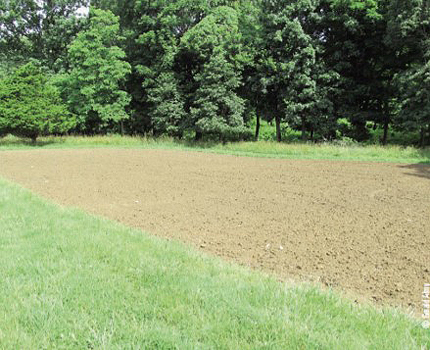
All From a Simple Radish Seed
In southern and mid-U.S. states, radishes should be planted from mid-summer to fall, but in northern states, they can be planted as early as June. They do particularly well when mixed with cereal grains, annual clovers or other brassicas for late summer/fall plantings.
Radishes are also extremely easy to grow, thriving in even moderate-quality soils, though fertilizing definitely helps — as does a pH above 6.0. They come up so well that one of the biggest dangers for the food plotter is putting them in too heavily and stunting their growth. You will likely still get adequate leaf growth if they’re a bit crowded, but if you want those huge root tubers as big as your forearm, you want to adhere to the proper planting rate. When it comes to soil contact, virtually all seeds planted on the surface or up to ¼ inch deep will germinate. And once they pop up out of the ground, they grow fast.
Other Benefits of Radishes for Deer
While many people know about some of these positive traits that radishes offer deer, not as many realize how many other benefits growing these remarkable plants gives back to the soil, the habitat and future crops that will be grown on the land. Farmers have learned about them more quickly because of their unique benefits and they are using radishes increasingly as a cover crop between growing seasons for corn, soybeans and other cash crops because they will actually improve the yield of following crops.
The United States Department of Agriculture (USDA) has researched radishes extensively and they are glowing in their descriptions of the benefits to soil and the environment from these plants. Among the many enhancements they offer are breaking up compacted soils, smothering and eradicating weeds, reducing erosion and topsoil runoff, killing harmful pests in the ground and scavenging nitrogen from deep in the soil and making it available for future plantings.
“The forage radish has a very large taproot which will break up soil compaction, retain soil moisture and contribute nitrogen for the spring-planted crop. Other benefits from forage radish are rapid growth in the fall, high biomass production, resistance to pests, weed suppression, organic matter build-up, erosion control and runoff reduction,” according to the USDA.
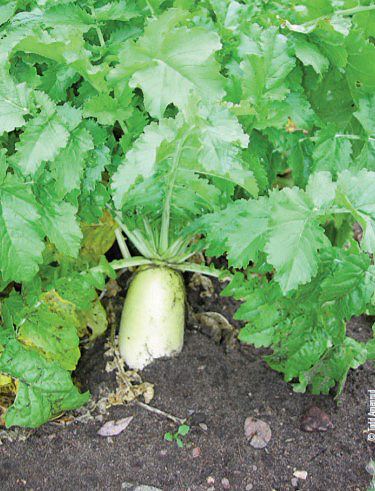
Let’s take a look at some of these radish benefits in more detail:
Soil Compaction
Most small-scale whitetail food plot growers don’t have big enough tractors to deep-rip soil or they neglect doing so. They ride over it repeatedly checking plots, planting, mowing, applying fertilizer, spraying herbicides and retrieving downed deer. Then they till the top five to 10 inches of soil in the spring. This results in dense, compacted soil that’s hard and insufficiently aerated. Moisture can’t penetrate very far, so plants utilize only the top soil layers.
Compacted soil also leaves nutrients and minerals in lower layers out of reach of growing plants, thus unable to be transferred to your deer.
Radishes grow a deep taproot that busts through that hardpan. Amazingly, it can penetrate three to six feet deep, with the upper thick “radish” part of the root penetrating one to two feet. That’s how these plants obtained the name “tillage radish” or “bio-drill.”
The plant literally plows or drills down through the hard ground. Then, when the root dies and decomposes (or, for us gamekeepers, is ripped out by our whitetails), it leaves channels or large holes in the ground that aerate the soil and allow water to penetrate. That, in turn, allows the roots of the next crops we grow to reach deeper into the soil, extracting moisture and nutrients. In a Maryland study, four times as many corn roots penetrated compact subsoil after a forage radish cover crop was grown compared to fields left fallow, and twice as many as after a rye cover crop was grown.
There’s another advantage to this “soil drilling” that radishes do, too. The root channels left allow the soil to aerate and dry up more quickly in spring so you can work fields sooner.
Nitrogen Scavenging Ability
As a radish root grows, it scavenges from 40-100 pounds of nitrogen per acre from deep in the soil where it’s been unavailable to other shallower-growing plants. When the roots die in spring, the plant leaves this nitrogen, along with other nutrients such as phosphorus and calcium, at higher levels where they can be absorbed by future plantings, reducing fertilizer costs. “Radish can act as a fertilizer for the next crop in the rotation by recycling nitrogen that would otherwise be lost through leaching,” according to the USDA’s Plant Guide. This is also helpful for the environment, as they point out: “Many cover crop species are nitrogen scavengers, but the roots of radish are able to absorb nitrogen at greater depths, preventing it from leaching into groundwater.”
Organic Matter
As radish plants die off, they return up to five tons of organic matter per acre, further improving the soil for the next crop. Fortunately, the leaves remaining on top that are killed by cold winter temperatures leave little physical residue, making ground preparation easy for the spring crop. “Biomass decomposes quickly and leaves the seedbed ready for planting, without the need to till or remove leftover residue,” says the USDA.
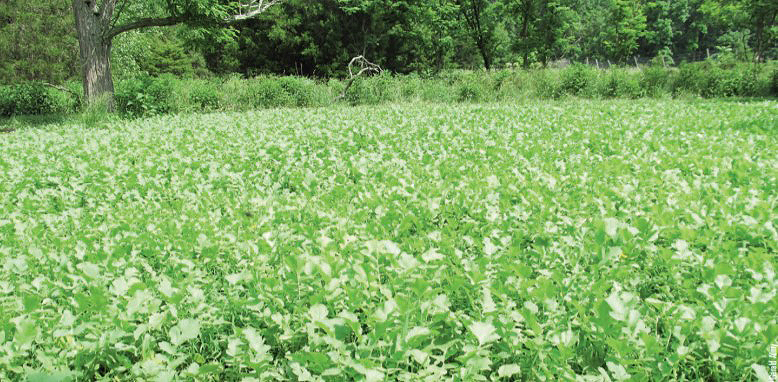
Erosion Control
The radish is a tremendous help when it comes to erosion and the deer food plot. Their deep-penetrating roots and fast growth also make radishes great cover crops for erosion control. They’re perfect for sites with moderate slopes to prevent runoff of fertilizers and herbicides that can harm waterways. They also prevent costly loss of topsoil and keep rainwater on the plot. The USDA says, “These plants provide good protection against wind and water erosion, which can be particularly helpful for muck or sandy soils.”
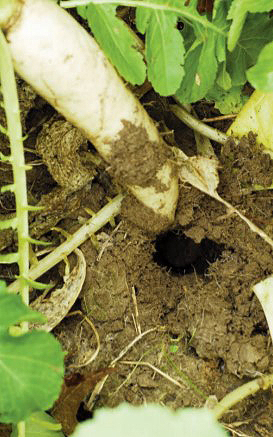
Weed Reduction
The fast establishment of radishes means they quickly outcompete most weeds and grasses, shading them out and corralling the available moisture with their deep taproots. This saves on herbicide use and time and gas devoted to mowing problem grasses and weeds. It also prepares the site well for a nearly weed-free plot the following spring, ready for another planting. A Michigan study found that radishes reduced weed biomass by 4,000 pounds per acre when compared to a fallow site.
Pest Control
If these weren’t enough fringe benefits, radishes can also help control and eradicate harmful pests in the soil such as nematodes that damage crops of both farmers and food plotters. These plants have high levels of compounds called glucosinolates (also known as glucosinolate [plural glucosinolates]), which are toxic to many soil-borne pests and pathogens, acting as natural bio-fumigants. More than 100 types of glucosinolates have been identified in brassicas. “The breakdown products of these glucosinolates are volatile,” says the USDA, “similar to the active chemical in the soil fumigant Vapam.” Glucosinolates in radishes can “trap sedentary beet cyst nematode and prevent reproduction of this pest that can damage crops.” Considering that nematodes are, numerically, the most abundant living animals on the planet, this is a major benefit to soils and crops.
Conclusion
Planting forages that attract deer to your property and provide valuable nutrition for the animals is satisfying in itself. But when your food plot also has tremendous benefits to the soil, the waterways, the habitat and future plantings on that site, it makes it particularly rewarding. I don’t know about you, but considering these double-barrel benefits and their long list of positives, I plan to make deer radishes a regular part of my food plot program every year. In so many ways, planting deer radishes in your food plot or as part of your crop rotations is a game changer. And maybe this season, instead of my arrow finding an old or a small-antlered buck dining on my radish plants, it will connect with a mature buck that also wears a B&C caliber rack.




























